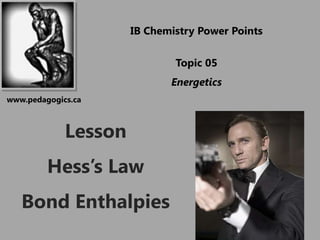5 3 and 5 4
- 1. IB Chemistry Power Points Topic 05 Energetics www.pedagogics.ca Lesson Hess’s Law Bond Enthalpies
- 2. Some taken from ENTHALPY CHANGES Great thanks to JONATHAN HOPTON & KNOCKHARDY PUBLISHING www.knockhardy.org.uk/sci.htm
- 3. HESS’S LAW “The overall enthalpy change of a chemical process is independent of the path taken” The enthalpy change going from A to B can be found by adding the values of the enthalpy changes for the reactions A to X, X to Y and Y to B. ΔHr = ΔH1 + ΔH2 + ΔH3
- 4. Consider three reactions 1. NaOH(s) + H2O NaOH (aq) + H2O ΔH1 Dissolving solid sodium hydroxide in water This process produces sodium and hydroxide ions ie. NaOH (aq) solution.
- 5. 2. NaOH (aq) +HCl (aq) NaCl (aq) + H2O ΔH2 Na+ OH- Reacting the sodium hydroxide solution with a hydrochloric acid solution = neutralization
- 6. 3. NaOH(s) + HCl (aq) NaCl (aq) + H2O ΔH3 Alternatively - add solid sodium hydroxide directly to hydrochloric acid solution. H3O+ Cl-
- 7. Recap: 1. NaOH(s) + H2O NaOH (aq) + H2O ΔH1 2. NaOH (aq) +HCl (aq) NaCl (aq) + H2O ΔH2 3. NaOH(s) + HCl (aq) NaCl (aq) + H2O ΔH3 Show that equation 1 plus equation 2 is the same as equation 3 What conclusion about enthalpy can be made?
- 8. Represented as an enthalpy level diagram NaOH (s) + HCl (aq) + H2O ΔH1 - 42 kJ/mol NaOH (aq) +HCl (aq) - 99 kJ/mol ΔH3 - 57 kJ/mol ΔH2 NaCl (aq) + H2O
- 9. Represented as an enthalpy cycle ΔH3 NaOH (s) + HCl NaCl (aq) + H2O + H2O + HCl ΔH1 ΔH2 NaOH (aq)
- 11. Enthalpy of reaction from bond enthalpies Theory Imagine that, during a reaction, all the bonds of reacting species are broken and the individual atoms join up again but in the form of products. The overall energy change will depend on the difference between the energy required to break the bonds and that released as bonds are made. energy released making bonds > energy used to break bonds ... EXOTHERMIC energy used to break bonds > energy released making bonds ... ENDOTHERMIC Step 1 Energy is put in to break bonds to form separate, gaseous atoms Step 2 The gaseous atoms then combine to form bonds and energy is released its value will be equal and opposite to that of breaking the bonds Applying Hess’s Law ΔHr = Step 1 + Step 2
- 12. Enthalpy of reaction from bond enthalpies Calculate the enthalpy change for the hydrogenation of ethene DH2 1 x C=C bond @ 611 = 611 kJ 4 x C-H bonds @ 413 = 1652 kJ 1 x H-H bond @ 436 = 436 kJ Total energy to break bonds (reactants) = 2699 kJ DH3 1 x C-C bond @ 346 = 346 kJ 6 x C-H bonds @ 413 = 2478 kJ Total energy to break bonds (products) = 2824 kJ DH = bonds broken – bonds made = (2699 – 2824) = – 125 kJ

